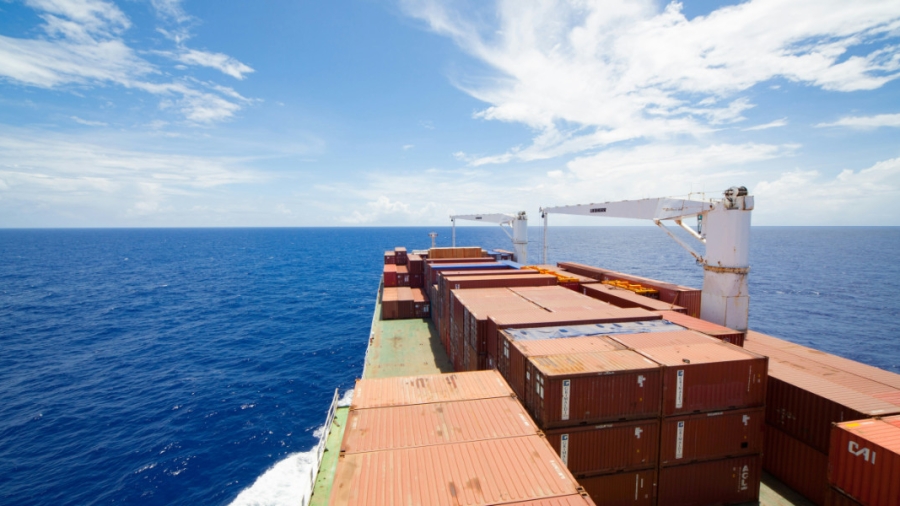Never has it been so cheap to inflict a world of economic pain.
This stark reality was highlighted last week by Maximilian Hess, a principal at London-based Enmetena Advisory, a political risk consultancy. During a webinar for supply chain managers, Hess showcased a slide of a canoe-sized naval drone, emphasizing the potential of such jury-rigged weapons to redirect global trade.
“Nowhere is this more clear than in the conflict in the Red Sea,” Hess remarked, referencing attacks launched from Yemen towards commercial ships navigating the Suez Canal.
Nearly six months into the Houthis’ relentless campaign, aimed at protesting Israel’s war in Gaza, the economic repercussions are expanding. Ships rerouted around Africa’s Cape of Good Hope are causing unpredictable schedules, leading to congestion at major Asian ports, shortages of empty containers in some locations, and surpluses in others. Delivery times to the U.S. and Europe are lengthening, and freight rates are soaring.
Several factors contribute to these disruptions, including robust demand for goods in the U.S. However, the latest wave of trade turmoil primarily stems from the Red Sea diversions. Sea-Intelligence, a Copenhagen-based maritime data and advisory firm, recently calculated that rerouting has increased the average minimum transit time by almost 40% to the Mediterranean from Asia, and by 15% to northern Europe.
The ripple effect of ships circling back to Asia — now off their timetables — is exacerbating bottlenecks in ports such as China’s Shanghai-Ningbo and Singapore. Jebel Ali in the United Arab Emirates is also experiencing congestion due to its proximity to the Red Sea and its role as a major transshipment hub for freight moving through Dubai by both ocean and air carriers.
Singapore, home to the world’s second-largest container port, issued a statement last week noting a significant increase in arrivals since the start of 2024. Container volumes rose by 8.8% from January through April compared to a year earlier. The port authority reported waits of two to three days for some vessels.
As ships spend more time at anchor and endure extended journeys, supply chain managers, burdened by the costs, feel pressured to place orders further in advance, sometimes buying more than necessary. The on-time arrival rate for container ships has plummeted to about 52%, reversing much of last year’s improvement from the pandemic-era lows of approximately 30% in early 2022, according to Sea-Intelligence.
Delivery times are particularly sluggish for goods traveling to Europe and the U.S. East Coast from China, as most ships on these routes avoid the Suez Canal shortcut.
On the demand side, the U.S. economy is exerting a strong pull, as evidenced by import volumes through the Port of Los Angeles during the first four months of the year. Early data for May volumes at the nation’s busiest port indicate continued momentum, with three of the past four weeks exceeding year-earlier levels.
This supply-demand imbalance is emerging at least a month before the peak shipping season from July to September, when retailers stock shelves for back-to-school sales and year-end holidays, placing large orders from their Asian suppliers. While it’s not yet at pandemic-level panic, some analysts warn that the situation could escalate when geopolitical risks and tariff threats are so pervasive.
“As more shippers start a peak season early, they create a capacity shortage and rates go up, causing other shippers to join the early stampede,” said Lars Jensen, a shipping analyst and founder of Copenhagen-based Vespucci Maritime. In the process, they’re “creating the crunch they hope to avoid,” he added.
Spot shipping rates have responded by rising sharply.
Air cargo, a much more expensive transportation mode, is also feeling the effects on specific routes as demand increases. Trine Nielsen, senior director and head of ocean EMEA at the logistics tech company Flexport Inc., noted that this suggests some cargo owners “expect the peak to sustain longer.”
Rogier Blocq, director of product development at Amsterdam-based WorldACD, reported that air cargo rates from the Persian Gulf and South Asia into Europe were up almost 80% in May compared to a year earlier, a significant increase from the global average rate rise of about 3% over the same period.
Just how long it will take for the interconnected system to return to balance is uncertain, according to Rolf Habben Jansen, chief executive of Hamburg, Germany-based Hapag-Lloyd AG, which ranks No. 13 on the Transport Topics list of the largest global freight companies.
“It could still last for another couple of months if the Red Sea situation doesn’t improve,” Jansen said in an interview last week on Bloomberg Television.



